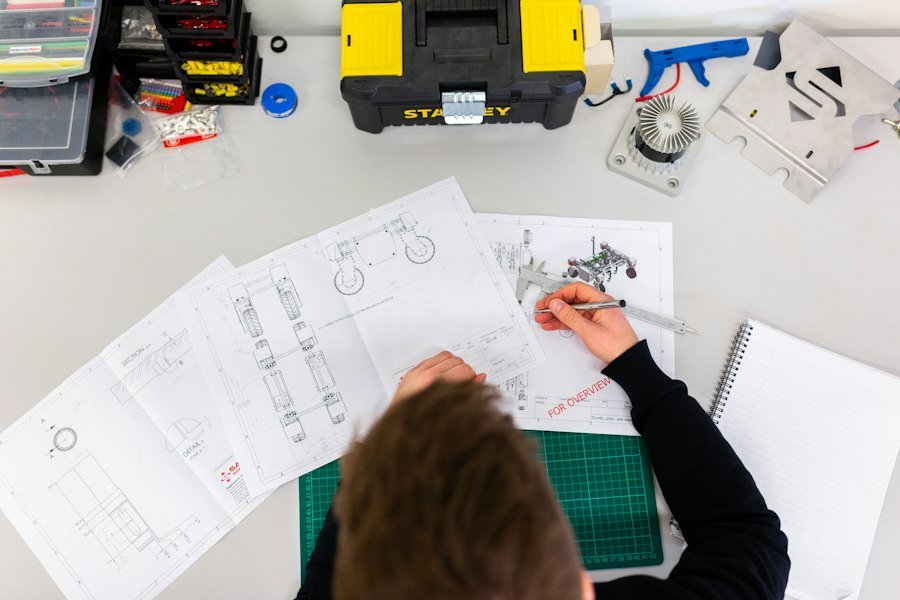

How to Discuss Engineering in Spanish: 20 Engineering Terms
In today’s globalized world, bilingualism is becoming increasingly important, especially in professional fields such as engineering. Being able to communicate effectively with colleagues and clients who speak different languages can greatly enhance collaboration and productivity. In the engineering field, where precision and accuracy are crucial, understanding and using the correct terminology is essential. Therefore, learning engineering terms in Spanish can be highly beneficial for engineers who work with Spanish-speaking colleagues or clients.
One of the main benefits of being able to communicate in Spanish is the ability to build stronger relationships with Spanish-speaking colleagues and clients. By speaking their language, engineers can establish trust and rapport, which can lead to more effective collaboration and problem-solving. Additionally, being bilingual in English and Spanish can open up new opportunities for engineers, as they can work on projects that involve Spanish-speaking countries or companies.
Table of Contents
ToggleKey Takeaways
- Learning engineering terms in Spanish can expand your professional opportunities and improve communication with Spanish-speaking colleagues and clients.
- Basic engineering terms in Spanish include “ingeniería” (engineering), “mecánica” (mechanics), and “electricidad” (electricity).
- To understand technical vocabulary in Spanish, use cognates, context clues, and online resources like specialized dictionaries and forums.
- Accurate pronunciation is crucial in engineering discussions to avoid misunderstandings and convey professionalism.
- Common engineering phrases in Spanish include “proyecto de ingeniería” (engineering project) and “análisis de datos” (data analysis).
Basic Engineering Terms in Spanish: A Quick Guide
To get started with learning engineering terms in Spanish, it is helpful to have a quick guide to common terms and their translations. Here are some examples:
– Engineering: Ingeniería
– Design: Diseño
– Construction: Construcción
– Project: Proyecto
– Analysis: Análisis
– Calculation: Cálculo
– Measurement: Medición
– Prototype: Prototipo
– Efficiency: Eficiencia
– Safety: Seguridad
Once you have a basic understanding of these terms, it is important to practice using them in context. For example, you could try translating simple sentences such as “I am an engineer” or “This project requires careful analysis” into Spanish. This will help you become more comfortable with using the terminology in real-life situations.
Understanding Technical Vocabulary in Spanish: Tips and Tricks
Technical vocabulary can often be challenging to understand, regardless of the language. However, there are strategies that can help you break down complex technical terms in Spanish. One approach is to look for familiar roots or prefixes that can provide clues about the meaning of the word. For example, the Spanish word for “electricity” is “electricidad,” which is similar to the English word “electricity.” By recognizing this similarity, you can make an educated guess about the meaning of the word.
Another helpful strategy is to use resources specifically designed for learning technical vocabulary in Spanish. Online dictionaries and glossaries can provide translations and definitions of technical terms, making it easier to understand and use them correctly. Additionally, there are specialized language courses and textbooks that focus on teaching engineering terminology in Spanish.
The Importance of Accurate Pronunciation in Engineering Discussions
In engineering discussions, accuracy and precision are key. This applies not only to the content of the conversation but also to the pronunciation of the words being used. Mispronunciation can lead to misunderstandings and confusion, which can have serious consequences in engineering projects.
To improve your pronunciation, it is important to practice speaking Spanish regularly. This can be done through conversation with native speakers or by using language learning apps that provide pronunciation exercises. It is also helpful to listen to recordings or watch videos of Spanish speakers pronouncing engineering terms correctly. By imitating their pronunciation and practicing regularly, you can develop a more accurate and confident speaking style.
Common Engineering Phrases in Spanish: Examples and Usage
In addition to individual terms, it is important to learn common phrases that are used in engineering discussions. Here are some examples:
– “¿Cuál es el objetivo de este proyecto?” (What is the objective of this project?)
– “Necesitamos hacer un análisis detallado de los datos” (We need to conduct a detailed analysis of the data)
– “La eficiencia energética es un factor clave en este diseño” (Energy efficiency is a key factor in this design)
– “¿Podrías explicar cómo funciona este sistema?” (Could you explain how this system works?)
– “Es importante garantizar la seguridad de los trabajadores” (It is important to ensure the safety of the workers)
By learning and practicing these phrases, you can engage in more meaningful and productive conversations with Spanish-speaking colleagues and clients.
Advanced Engineering Terminology in Spanish: Navigating Complex Concepts

As you become more proficient in Spanish, you may encounter more complex engineering terms that require a deeper understanding. Here are some examples:
– Thermodynamics: Termodinámica
– Structural analysis: Análisis estructural
– Fluid mechanics: Mecánica de fluidos
– Finite element analysis: Análisis de elementos finitos
– Control systems: Sistemas de control
To navigate these complex concepts, it is helpful to break down the terms into their individual components and understand the meaning of each component. For example, “termodinámica” can be broken down into “termo” (heat) and “dinámica” (dynamics), which gives a clue about the study of heat and its relationship with motion. By understanding the individual components, you can gain a better understanding of the overall concept.
How to Ask Questions and Seek Clarification in Spanish Engineering Discussions
In engineering discussions, it is important to ask questions and seek clarification when needed. This is especially true when communicating in a second language such as Spanish. Here are some tips for asking questions and seeking clarification in a professional manner:
– Be polite and respectful: Use formal language and address the person with appropriate titles such as “señor” or “señora.”
– Be specific: Clearly state what you need clarification on or what information you are seeking.
– Use appropriate language: Use technical terms and vocabulary to ensure that your question is understood correctly.
– Repeat or rephrase: If you do not understand the response, ask the person to repeat or rephrase their answer in a different way.
Here is an example of how to ask a question in Spanish: “Disculpe, ¿podría explicar nuevamente cómo funciona este sistema de control?” (Excuse me, could you explain again how this control system works?)
Using Contextual Clues to Enhance Your Understanding of Engineering Terms in Spanish
When encountering unfamiliar engineering terms in Spanish, it can be helpful to use contextual clues to enhance your understanding. Contextual clues include the surrounding words and phrases that provide hints about the meaning of a particular term. For example, if you come across the phrase “análisis de datos” (data analysis), you can infer that “análisis” refers to the process of analyzing and “datos” refers to data.
Additionally, paying attention to the context in which a term is used can provide further clues about its meaning. For example, if you are discussing a construction project and someone mentions “cimientos” (foundations), you can infer that it refers to the base or support structure of a building.
Resources for Learning and Practicing Spanish Engineering Vocabulary
There are numerous resources available for learning and practicing Spanish engineering vocabulary. Online platforms such as Duolingo, Babbel, and FluentU offer courses specifically designed for learning technical vocabulary in various fields, including engineering. These courses often include interactive exercises and quizzes to reinforce learning.
In addition to online resources, there are also opportunities for practicing Spanish in a professional setting. Many engineering companies have international offices or work with clients from Spanish-speaking countries. By seeking out these opportunities and actively engaging with Spanish-speaking colleagues or clients, you can further develop your language skills and gain practical experience using engineering terms in real-life situations.
Putting It All Together: Strategies for Effective Communication in Spanish Engineering Contexts
To effectively communicate in Spanish engineering contexts, it is important to apply the strategies discussed throughout this article. Here are some tips for effective communication:
– Build a strong foundation: Start by learning basic engineering terms and phrases, and practice using them in context.
– Develop technical vocabulary: Use resources specifically designed for learning technical vocabulary in Spanish to expand your knowledge.
– Focus on pronunciation: Practice speaking Spanish regularly and seek feedback on your pronunciation to ensure accuracy.
– Ask questions and seek clarification: Be proactive in asking questions and seeking clarification when needed, using appropriate language and tone.
– Use contextual clues: Pay attention to the context in which terms are used to enhance your understanding.
– Practice regularly: Engage in conversations with Spanish-speaking colleagues or clients, and seek out opportunities to use Spanish in a professional setting.
By applying these strategies consistently, you can become more confident and proficient in using engineering terms in Spanish, leading to more effective communication and collaboration in the engineering field.
In conclusion, learning engineering terms in Spanish is highly beneficial for engineers who work with Spanish-speaking colleagues or clients. Bilingualism can enhance collaboration and productivity, while also opening up new opportunities for engineers. By learning basic engineering terms, understanding technical vocabulary, improving pronunciation, and practicing common phrases, engineers can effectively communicate and collaborate in Spanish-speaking engineering contexts. With the resources available for learning and practicing Spanish engineering vocabulary, engineers can continue to develop their language skills and enhance their professional capabilities.
If you want to learn Norwegian, you can register for classes here. We look forward to hearing from you and helping you become fluent in Norwegian.





